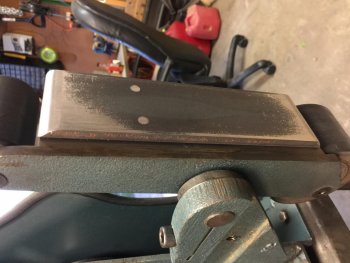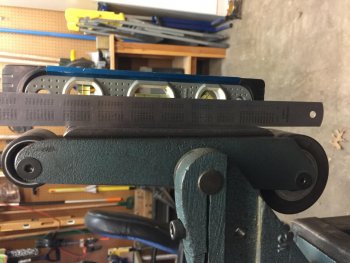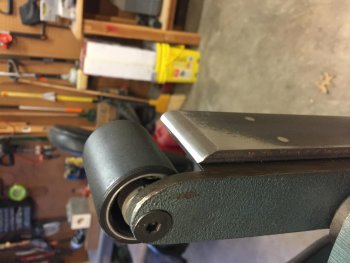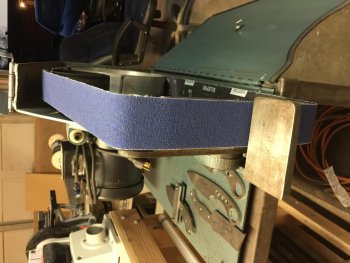You are using an out of date browser. It may not display this or other websites correctly.
You should upgrade or use an alternative browser.
You should upgrade or use an alternative browser.
New (to me) Grinder
- Thread starter Jellis11
- Start date
EdCaffreyMS
"The Montana Bladesmith"
YEP! Just make sure that it's 2" wide and the edges are parallel. When you position it on the platen body, use a straight edge to align the platen face material with the edges of the top and bottom contact wheels. 
Last question Ed, and then I'll be posting pictures of your modification on my machine....In your pictures you have three sets of holes drilled in your stock platen, but you are only using the top set of two, correct? Is that enough to keep it in place? (I am using 10-24 socket head bolts as you suggested)
Also, and this may be a dumb question, but can you use the section of belt between the top front wheel and the idler pulley (directly under the vertically opening door) for a slack belt?
Also, and this may be a dumb question, but can you use the section of belt between the top front wheel and the idler pulley (directly under the vertically opening door) for a slack belt?
EdCaffreyMS
"The Montana Bladesmith"
I used 1/4-20 socket head bolts, but 10-24s should be OK. What I did was to make the "through holes" on the original platen body slightly oversized..... once the add-on platen face is on, the bolts tightened, and a belt on the machine, you can then slightly loosen, and adjust the add on platen face so the edges align with the belt.....then tighten them back down, and all should be good. Where you need to pay attention is trimming the socket head bolts.... if the threaded end sticks out ANY AT ALL beyond the face of the platen, it will shred a belt the first time you apply pressure/try to grind something. If you're not going to apply glass to the platen face, a little trick I use is to put on a 120 or 220 grit belt, with the grit side facing inward, and run it for just enough time to flush up the threaded ends of the socket head bolts....that is IF there is any need to do so.
That's actually a BRILLIANT question! That is specifically why I trimmed the original platen....to have that slack belt area available..... I have the same arrangement on my KMG grinder.....it's were I apply/finish my convex edges.Also, and this may be a dumb question, but can you use the section of belt between the top front wheel and the idler pulley (directly under the vertically opening door) for a slack belt?
Last edited:
Cool! I'm excited to get this done and start grinding!
I should post this on another thread, but since you have been a tremendous help so far, hopefully you don't mind if I ask another few...
Just so I got everything straight in my head the process in its simplest form is something like this: (?????)
1. Grind out shape and bevels on grinder
2. Hand sand flats and bevels to 220 or 320g
3. Heat treat & temper (scrub carbon junk off between temper cycles)
4. Clean up bevels and flats on grinder with 320g +
5. Hand sand flats to 600g (leave high grit horizontal grind marks in bevel?)
6. Finish, handle, etc
I should post this on another thread, but since you have been a tremendous help so far, hopefully you don't mind if I ask another few...
Just so I got everything straight in my head the process in its simplest form is something like this: (?????)
1. Grind out shape and bevels on grinder
2. Hand sand flats and bevels to 220 or 320g
3. Heat treat & temper (scrub carbon junk off between temper cycles)
4. Clean up bevels and flats on grinder with 320g +
5. Hand sand flats to 600g (leave high grit horizontal grind marks in bevel?)
6. Finish, handle, etc
EdCaffreyMS
"The Montana Bladesmith"
1. Grind out shape and bevels on grinder
Yep.....some notes:
-leave your edge 3/32"+ thick..... the thicker you leave things, the less likely things will warp in the heat treat.
2. Hand sand flats and bevels to 220 or 320g
-I don't hand sand before heat treat, but you can. Got to at least 120 grit finish....any scratches larger then 120 grit CAN create stress risers.... places were cracks can happen.
Yep....this is always the area where the most trial and error comes in....everybody uses slightly different setups/methodologies.....and there are always variables present to deal with.3. Heat treat & temper (scrub carbon junk off between temper cycles)
4. Clean up bevels and flats on grinder with 320g +
Post heat treat grinding is what most call "Finish grinding". In this step you want to do as much as possible on the grinder, as the heat treated steel is very difficult to hand sand (compared to pre-heat treat). I start with a fresh heavy grit (50) belt, and leave only enough for me to work through the rest of the grits I intend to use....it's always a bit of a guessing game, but it's get easier with time/repetition. That being said, you have to do it according to your current skill and comfort level. Generally I will go to 400 or 600 on the grinder, making the knife as close to finish as I can get it, in order the minimize having to remove material by hand.
5. Hand sand flats to 600g (leave high grit horizontal grind marks in bevel?)
You can do that, or finish everything out evenly.....some makers create a nice look by having different levels of finish on different part of a blade.....again, your skill and comfort level will dictate things.
Yep.... lots of things involved there.....but it gets more comfortable with each one.6. Finish, handle, etc
EdCaffreyMS
"The Montana Bladesmith"
Most of the time you can't grind a different angles on the belt grinder.....if you do, you generally mess up on part of the blade or another....what you do have to do it start training your eyes to pick or previous grit scratches. At first what you'll do is think you have all the scratches out, move on to the next grit....and discover you missed some. Just go back to the last grit and try again.... in the beginning you might have to do that a few times. 
The biggest thing you MUST remember when finish grinding.... the steel has been heat treated, HEAT IS YOUR ENEMY! No gloves! If the steel is too home to hold comfortably in your bare hands, then it's too hot! I feel that's very important considering the belt speed on a Square Wheel. If you change the color ANY during finishing grinding....you're done (at least as far as I'm concerned). I always have a 5 gallon bucket of soapy water hanging below all my grinders......catches much of the swarf from grinding, and makes a handy source of cooling.
The biggest thing you MUST remember when finish grinding.... the steel has been heat treated, HEAT IS YOUR ENEMY! No gloves! If the steel is too home to hold comfortably in your bare hands, then it's too hot! I feel that's very important considering the belt speed on a Square Wheel. If you change the color ANY during finishing grinding....you're done (at least as far as I'm concerned). I always have a 5 gallon bucket of soapy water hanging below all my grinders......catches much of the swarf from grinding, and makes a handy source of cooling.
Gene Kimmi
KNIFE MAKER
Perfect! When finish grinding do I need to grind each grit at different angles (taking out scratches from previous grit) as I would hand sanding?
One trick I found kind that helps on areas such as the bevels where you can't sand at different angles is to use a large black sharpie to color the whole area. I did this to make sure I was grinding flat each time, but found that the lower grit scratches would stay black. Makes it a little easier to see when they are gone. Good lighting and looking at it from many angles still required.
use a large black sharpie to color the whole area. .
Makes perfect sense, thanks Gene!
EdCaffreyMS
"The Montana Bladesmith"
Only thing that worries me is the gap (shown with my strait edge) is this too much?
I had/have the same issue with my Square Wheel..... the "cams" on the contact wheels will only move the wheels so much..... it's one of those "give-n-take" things. You need that gap, but too much creates more belt friction/heat. It didn't have much affect on my machine...but then again, I had the small drive wheel in place, that slowed the belt speed by approx. 1/2.... so mine doesn't generate as much heat as your's will. Just keep an eye on it, and if it gets so hot that it starts popping belt joints, you'll know it's time to go to a VFD setup.
The good news is that down the road, if you do decide on another grinder, the square wheel works really well with the 8"-10" contact wheels..... it's just the flat platen that's the downfall of the machine.
I just wonder....perhaps too drastic, but could you drill new mounting holes for the wheels to set maybe 1/2" forward? seems like there could be room.
Actually, now that I think about it....a really resourceful guy could build a new platen fixture....Hmmmm......??
Actually, now that I think about it....a really resourceful guy could build a new platen fixture....Hmmmm......??
Last edited:
EdCaffreyMS
"The Montana Bladesmith"
Actually, now that I think about it....a really resourceful guy could build a new platen fixture....Hmmmm......??
Exactly!
I tried to "fix" all the things I didn't like about the Square Wheel platen, and kept those attributes I liked.
Wheels are turning......I think I could cut the same platen pattern and configuration for the wheel attachment points, weld the 3/4"(?) rod for the swivel action, but make the platen face in a way that I could adjust it in or out independently (horizontally)
Oh well, I have something to work with at least while I'm sorting out modifications...
Oh well, I have something to work with at least while I'm sorting out modifications...
Don Robinson
Well-Known Member
During my knifemaking years, I bought or made several belt grinders, including the top names. I got rid of all of them and kept the SW. So I've probably made hundreds of knives and folders using only the SW. I still have it and use it regularly.






